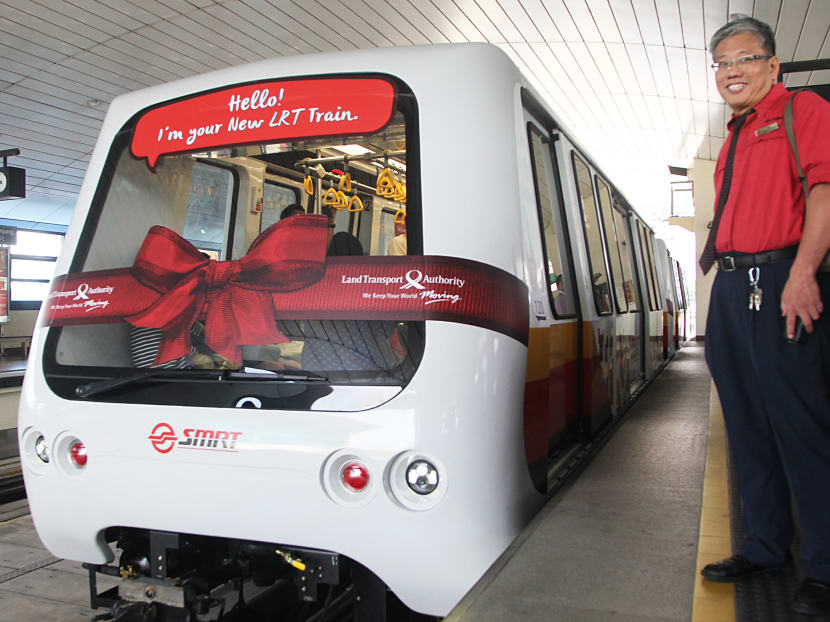Millions to be spent on improving the Bukit Panjang LRT
SINGAPORE — Plagued by disruptions since it started operations about 16 years ago, the loss-making Bukit Panjang Light Rail Transit (BPLRT) system will undergo its most comprehensive enhancement to date — costing millions of dollars — to improve its reliability.
SINGAPORE — Plagued by disruptions since it started operations about 16 years ago, the loss-making Bukit Panjang Light Rail Transit (BPLRT) system will undergo its most comprehensive enhancement to date — costing millions of dollars — to improve its reliability.
Announcing the slew of initiatives — which are expected to be completed in six to nine months — the Land Transport Authority (LTA) and public transport operator SMRT said today (June 25) they have identified system faults causing the loss of train signals and traction power as the key contributors of past incidents.
As the system would have been in operation for two decades in 2019, the LTA said it will embark on a full review of the BPLRT system, including conducting an engineering study. More details will be announced later.
Meanwhile, SMRT is working with Bombardier Transport, which supplied the BPLRT system, to address the system faults. Among other measures, SMRT will be replacing the power rail brackets — which hold the power and signal rails - at LRT crossings. Cameras will also be installed on the under-frame of the train-cars to better monitor the alignment and contact between the train-cars’ collector shoes and power rails. More operations and maintenance staff will be hired to ensure quicker recovery during delays.
LTA chief executive Chew Men Leong said the BPLRT system has “served the community well but it has its fair share of reliability challenges over the years”. Previous efforts have yielded some improvements but these “specific, targeted measures” would improve the system’s robustness, he added.
SMRT Trains managing director Lee Ling Wee said the operator would bear the full cost of the measures. He declined to reveal the exact amount, and would only say that it “runs in the millions”.
Mr Lee said SMRT will work closely with LTA to on a “holistic and comprehensive review of the total transport needs” of the residents in Bukit Panjang, given the increase in the precinct’s population. “It’s about time we start studying it, it may take a few years and we see whether there are any recommendations we can come up with,” he added.
The LRT network has been feeling the pressure of its ageing infrastructure and growing ridership, especially for the BPLRT network. Last year, it registered 3.95 delays lasting more than five minutes for every 100,000km clocked, the highest among rail lines here. A severe disruption in March saw the system shut down for 23 hours after a power trip caused by a fire.
Since its opening in 1999, average daily ridership ridership on the BPLRT system has increased by 15,000 to 54,000. However, SMRT’s LRT division has remained in the red since day one. For the financial year ending March 31, losses at the division increased to S$3.8 million, from S$2.1 million the previous year.
It was previously announced that 13 new train-cars would be added to the network by the third quarter of this year. To date, seven train-cars have been put in service.
Transport analysts noted that the enhancement measures announced today would bring some relief to commuters. However, these were focused mainly on the engineering aspects, and LTA and SMRT might need to look at improving accessibility and comfort for commuters.
National University of Singapore transport researcher Lee Der Horng said the authorities might wish to consider redesigning the Bukit Panjang estate around the LRT network. He noted that in the newer towns of Sengkang and Punggol, the LRT systems were integrated seamlessly, making transfers a breeze for commuters. In contrast, the LRT system was built in Bukit Panjang after the estate was already developed.
Dr Park Byung Joon, a transport expert, said the BPLRT system “did not meet initial expectations”, and it took a long time for ridership to grow. Nevertheless, he added: “There is a limit to how much ridership can grow, it only serves a limited number of people living in a certain area.”
Mr Liang Eng Hwa, the constituency’s Member of Parliament, said that the BPLRT enhancements, along with the improved bus services and the new Downtown Line MRT station to be built in Bukit Panjang, will provide the residents with more public transport options.
“Going forward what we need to do is to make sure the three modes of transport synergise better and better complement each other,” he said.
For now, Bukit Panjang residents whom TODAY spoke to were lukewarm about the LRT enhancements.
Homemaker Winnie He, 30, said that she seldom use the LRT as it takes about 25 minutes for her to travel from Segar LRT station near her home to Choa Chu Kang LRT station where commuters can transfer to the MRT network.
Producer Shawn Lee, 36, pointed out that it is faster to travel by bus from Bukit Panjang to downtown - it takes about 20 minutes on bus service 972 to get to Orchard Road. “I’ll still continue to take the bus because it’s easier to get to where I want to go,” he said.







